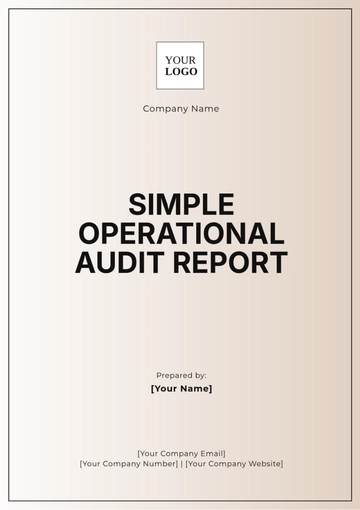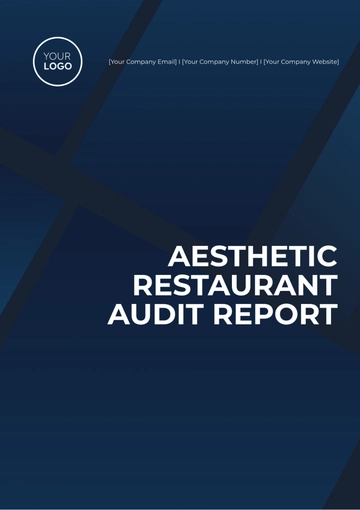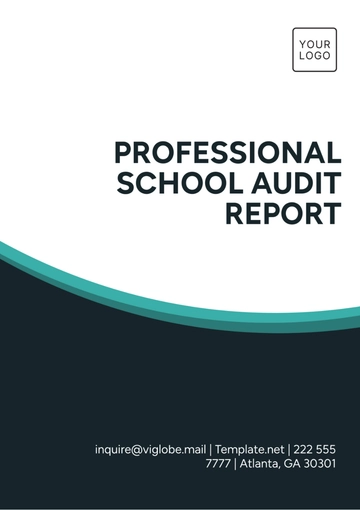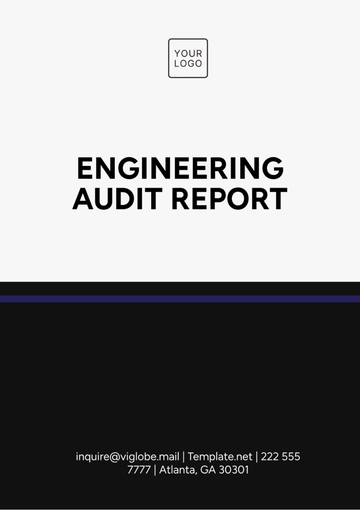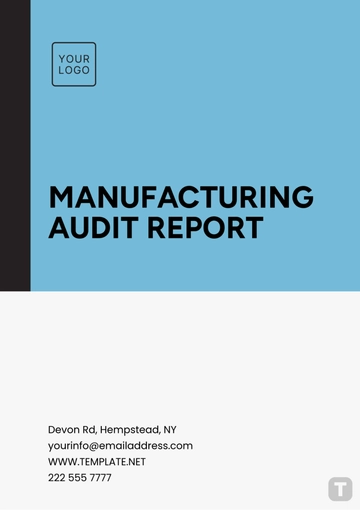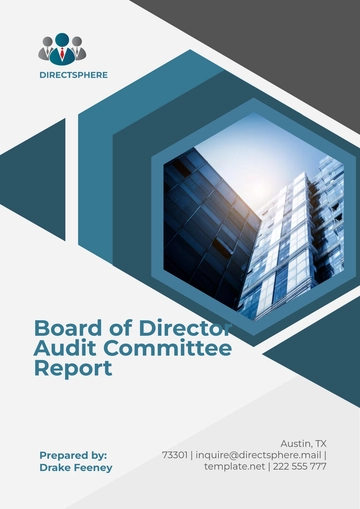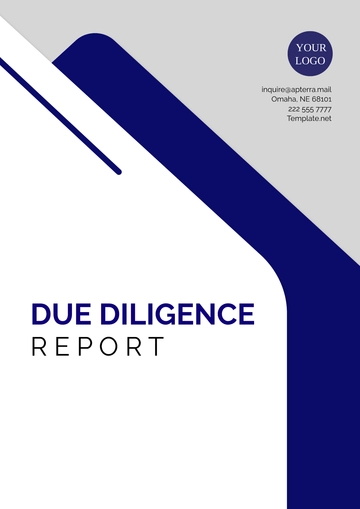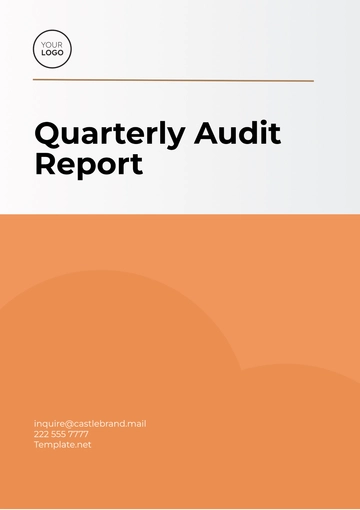Free Restaurant Audit Report

I. Executive Summary
A. Overview
The assessment encompasses various facets of the restaurant's operations, including cleanliness, customer service, inventory management, financial performance, marketing strategies, and sustainability initiatives. By analyzing these critical areas, [Your Company Name] aims to provide actionable insights to support the restaurants in achieving operational excellence and long-term success.
B. Key Findings
The audit revealed several areas of improvement in cleanliness and hygiene standards, particularly in the kitchen area. Issues such as grease buildup on surfaces and inadequate sanitation practices were noted, posing potential health risks to both staff and patrons. Addressing these issues promptly is crucial to maintaining a safe and hygienic environment for food preparation.
Customer service received positive feedback, with commendations for staff friendliness and responsiveness. However, opportunities exist to further enhance service quality through ongoing training and development initiatives. Investing in staff training programs can empower employees to deliver exceptional service consistently.
Inventory management practices were found to be lacking, leading to potential revenue loss and operational inefficiencies. Discrepancies between recorded inventory levels and actual stock counts were identified, highlighting the need for improved tracking mechanisms. Implementing robust inventory management systems can streamline operations and minimize inventory-related risks.
Financial performance analysis revealed fluctuations in revenue streams and opportunities for cost-saving measures. Strategies such as targeted marketing efforts and renegotiation of supplier contracts can optimize revenue streams and improve profit margins.
Sustainability initiatives were found to be limited, presenting an opportunity for [Your Company Name] to implement environmentally friendly practices such as waste reduction and energy efficiency measures. Embracing sustainability can not only reduce costs but also enhance brand reputation and attract environmentally conscious customers.
C. Recommendations
Based on the findings, recommendations have been provided to address the identified issues and enhance overall operational efficiency, customer satisfaction, financial performance, and sustainability. These recommendations include implementing robust cleaning schedules, investing in inventory management software, providing staff training programs, optimizing marketing strategies, and embracing sustainability initiatives. By adopting these recommendations, [Your Company Name] can position itself as a leader in the restaurant industry, delivering exceptional experiences while maximizing profitability and minimizing environmental impact.
II. Introduction
A. Purpose
The purpose of this audit report is to assess the operational performance of [Your Company Name]'s restaurant establishments and identify areas for improvement across various dimensions such as cleanliness, customer service, inventory management, financial performance, marketing strategies, and sustainability initiatives. By conducting a comprehensive evaluation, [Your Company Name] aims to provide actionable insights that will support the restaurants in achieving operational excellence and long-term success in a competitive market landscape.
B. Scope
The audit covered all operational aspects of [Your Company Name]'s restaurant establishments, including but not limited to, food preparation areas, dining areas, staff performance, safety and hygiene standards, inventory management practices, financial performance metrics, marketing strategies, and sustainability initiatives. Through onsite inspections, interviews with staff members, analysis of relevant documentation, and benchmarking against industry best practices, a thorough assessment was conducted to gain a holistic understanding of the restaurants' performance and identify opportunities for improvement.
C. Methodology
The audit was conducted through a combination of onsite inspections, interviews with staff members, analysis of relevant documentation such as inventory records, financial statements, customer feedback forms, marketing materials, and sustainability reports. By employing a multi-faceted approach, [Your Company Name] ensured comprehensive coverage of the restaurants' operations, enabling a thorough evaluation of their strengths, weaknesses, opportunities, and threats.
III. Operational Performance
A. Cleanliness and Hygiene Standards
Area | Findings | Recommendations |
|---|---|---|
Kitchen Area | Several instances of grease buildup and inadequate sanitation practices were noted. | Implement a rigorous cleaning schedule and enhance staff training on proper hygiene practices. |
Dining Areas | Overall, the dining areas were well-maintained, but minor cleanliness issues were observed. | Establish regular monitoring and maintenance protocols to uphold cleanliness standards consistently. |
Restrooms | Hygiene standards in the restrooms were satisfactory, with regular cleaning schedules observed. | Maintain vigilance and adherence to established protocols to ensure restroom cleanliness remains optimal. |
B. Customer Service
Aspect | Findings | Recommendations |
|---|---|---|
Staff Friendliness | Customers expressed high levels of satisfaction with staff friendliness and professionalism. | Provide ongoing training and development programs to further enhance staff interaction skills and professionalism. |
Responsiveness | Staff demonstrated prompt responsiveness to customer requests and inquiries. | Establish clear communication channels and efficient workflow processes to sustain high levels of responsiveness. |
C. Inventory Management
Aspect | Findings | Recommendations |
|---|---|---|
Stock Levels | Discrepancies between recorded inventory levels and actual stock counts were identified. | Invest in inventory management software to enable real-time monitoring and accurate stock replenishment. |
Waste Management | Inefficient handling of perishable items resulted in higher levels of food waste. | Optimize procurement practices and implement waste reduction strategies to minimize costs and improve profitability. |
IV. Financial Performance
A. Revenue Analysis
Analysis | Findings | Recommendations |
|---|---|---|
Sales Trends | Analysis of sales data identified fluctuations in revenue streams. | Develop targeted marketing efforts to boost sales during off-peak periods based on data-driven insights. |
Profit Margins | Examination of profit margins revealed opportunities for cost-saving measures. | Renegotiate supplier contracts and optimize menu offerings to improve profit margins while maintaining competitiveness. |
B. Cost Analysis
Analysis | Findings | Recommendations |
|---|---|---|
Operational Expenses | Areas for cost-saving measures were identified without compromising service quality. | Streamline operational processes and leverage economies of scale to achieve greater cost efficiency. |
Labor Costs | Potential inefficiencies in staffing levels and scheduling were highlighted. | Adopt flexible staffing arrangements and implement performance-based incentives to optimize labor costs. |
V. Marketing Strategies
A. Online Presence
Website: [Your Company Name]'s website serves as a crucial platform for engaging with customers and promoting its brand. An analysis of the website's usability, content, and search engine optimization (SEO) performance revealed opportunities for improvement. Enhancing the website's user experience and optimizing content for relevant keywords can improve visibility and attract more traffic.
Social Media: [Your Company Name] maintains active profiles on various social media platforms, including Facebook, Instagram, and Twitter. Engagement metrics such as likes, shares, comments, and follower growth were analyzed to assess the effectiveness of [Your Company Name]'s social media strategy. Leveraging social media analytics and adopting targeted content strategies can enhance brand awareness, drive customer engagement, and increase foot traffic to the restaurants.
B. Loyalty Programs
[Your Company Name] operates loyalty programs to reward repeat customers and encourage customer retention. An analysis of loyalty program membership, participation rates, redemption rates, and customer engagement levels was conducted to evaluate the effectiveness of these programs. Recommendations include enhancing the value proposition of loyalty programs, personalizing offers based on customer preferences, and leveraging data analytics to segment customers effectively.
C. Promotional Campaigns
[Your Company Name] periodically launches promotional campaigns to attract new customers and drive sales. An analysis of past campaigns, including their reach, engagement, and conversion rates, was conducted to assess their impact on revenue generation. Recommendations include aligning promotional campaigns with seasonal trends, leveraging customer feedback to tailor offers, and integrating digital marketing channels for maximum reach and impact.
VI. Sustainability Initiatives
A. Environmental Practices
[Your Company Name] is committed to implementing environmentally friendly practices to minimize its carbon footprint and promote sustainability. An analysis of current sustainability initiatives, including waste management practices, energy efficiency measures, and sourcing policies, was conducted to identify areas for improvement. Recommendations include investing in renewable energy sources, implementing waste reduction strategies, and sourcing ingredients from sustainable and local suppliers.
B. Community Engagement
[Your Company Name] actively engages with the local community to support environmental conservation efforts and promote sustainability awareness. An analysis of community engagement initiatives, including partnerships with local organizations and participation in community events, was conducted to assess their impact and effectiveness. Recommendations include expanding community outreach efforts, organizing educational workshops on sustainability, and encouraging employee volunteering activities.
VII. Conclusion
The audit report provides comprehensive insights into the operational performance of [Your Company Name]'s restaurant establishments across various dimensions, including cleanliness, customer service, inventory management, financial performance, marketing strategies, and sustainability initiatives. By addressing the identified issues and implementing the proposed recommendations, [Your Company Name] can enhance operational efficiency, customer satisfaction, profitability, and environmental sustainability. [Your Company Name] remains committed to continuous improvement and innovation, ensuring that its restaurant establishments remain leaders in the industry and champions of sustainability.
- 100% Customizable, free editor
- Access 1 Million+ Templates, photo’s & graphics
- Download or share as a template
- Click and replace photos, graphics, text, backgrounds
- Resize, crop, AI write & more
- Access advanced editor
Evaluate performance with Template.net's Restaurant Audit Report Template. This customizable document provides a professional format for documenting the findings, conclusions, and recommendations from audits conducted in your restaurant. Enhance transparency and accountability. Editable in our Ai Editor Tool for seamless customization to fit your restaurant's audit reporting requirements and stakeholders' needs.
You may also like
- Sales Report
- Daily Report
- Project Report
- Business Report
- Weekly Report
- Incident Report
- Annual Report
- Report Layout
- Report Design
- Progress Report
- Marketing Report
- Company Report
- Monthly Report
- Audit Report
- Status Report
- School Report
- Reports Hr
- Management Report
- Project Status Report
- Handover Report
- Health And Safety Report
- Restaurant Report
- Construction Report
- Research Report
- Evaluation Report
- Investigation Report
- Employee Report
- Advertising Report
- Weekly Status Report
- Project Management Report
- Finance Report
- Service Report
- Technical Report
- Meeting Report
- Quarterly Report
- Inspection Report
- Medical Report
- Test Report
- Summary Report
- Inventory Report
- Valuation Report
- Operations Report
- Payroll Report
- Training Report
- Job Report
- Case Report
- Performance Report
- Board Report
- Internal Audit Report
- Student Report
- Monthly Management Report
- Small Business Report
- Accident Report
- Call Center Report
- Activity Report
- IT and Software Report
- Internship Report
- Visit Report
- Product Report
- Book Report
- Property Report
- Recruitment Report
- University Report
- Event Report
- SEO Report
- Conference Report
- Narrative Report
- Nursing Home Report
- Preschool Report
- Call Report
- Customer Report
- Employee Incident Report
- Accomplishment Report
- Social Media Report
- Work From Home Report
- Security Report
- Damage Report
- Quality Report
- Internal Report
- Nurse Report
- Real Estate Report
- Hotel Report
- Equipment Report
- Credit Report
- Field Report
- Non Profit Report
- Maintenance Report
- News Report
- Survey Report
- Executive Report
- Law Firm Report
- Advertising Agency Report
- Interior Design Report
- Travel Agency Report
- Stock Report
- Salon Report
- Bug Report
- Workplace Report
- Action Report
- Investor Report
- Cleaning Services Report
- Consulting Report
- Freelancer Report
- Site Visit Report
- Trip Report
- Classroom Observation Report
- Vehicle Report
- Final Report
- Software Report



